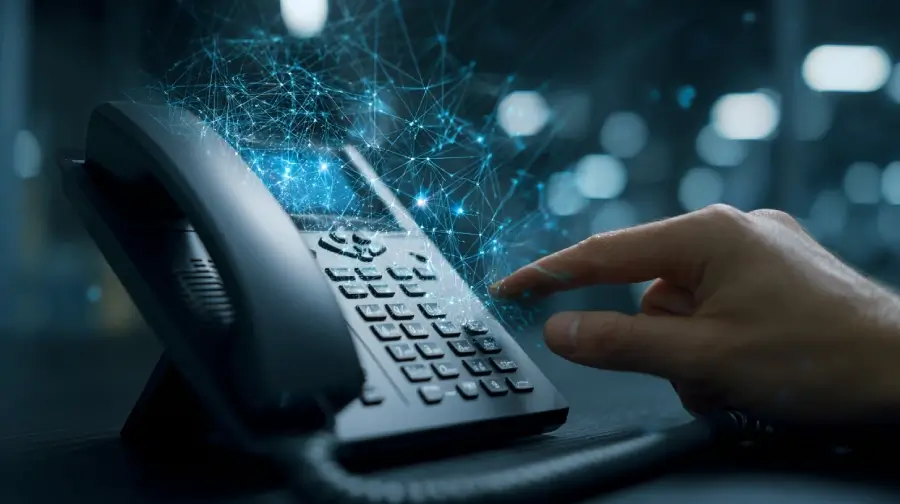VoIP and the Internet of Things
Lazaros Agapidis

Introduction
One of the fastest growing sectors of ICT is that known as the Internet of Things, often referred to simply as IoT. Arguably, IoT is also one of the most mysterious sectors in the telecom industry. It is so different from the traditional and mainstream services that we daily come into contact with, and that is one of the reasons why it is so difficult to grasp.
IoT is not being developed in a vacuum, but is capable of interoperating with other network platforms such as Voice over IP, enriching and augmenting applications for new and useful services. In this article, we’ll take a look at what IoT is and how its integration with VoIP can enhance both IoT and voice services and infrastructure.
What is IoT?
IoT can be defined as the interconnection of network-enabled “things” over the Internet that continually collect, send, receive, and share data. These “things” can be physical objects, devices, vehicles, or even buildings, that are endowed with electronics, software, sensors, actuators, speakers, screens, and other input and output mechanisms. IoT-enabled items can be stand-alone entities that are specifically designed to be used within an IoT environment such as smart sensors that measure light, temperature, humidity, motion, and CO2 levels, for example. They can also be equipment and appliances that have been around for years and have simply been made “smart” and connected by the addition of electronics and software. Such devices could include cars, washing machines, traffic lights, or a home alarm system.
IoT is here to stay. According to some estimates, every second, another 127 devices are connected to the Internet, and there will be 41 billion IoT devices by 2027.

The power behind IoT
With this brief description, the benefits and potential of IoT may not be immediately perceivable. One of the reasons behind this is that IoT primarily involves machine to machine (M2M) communication, and we as humans don’t participate directly in that interaction. The benefits that we see from IoT come not from the M2M interaction of each individual IoT device, but result from the combined synergy of hundreds, thousands, or even tens of thousands of devices simultaneously.
Connectivity is the Key
Connectivity of IoT devices is what drives the usefulness and value of IoT. Connectivity enables IoT things to be controlled remotely, ether individually or en masse, by a remote centralized control system. Things can act intelligently based on information received from this control system or from other connected things. An extensively large number of things can collect vast amounts of useful information over time that can be stored and analyzed. All of this results in the creation of a more direct integration of the physical world into computer-based systems resulting in improved efficiency, economic benefits, as well as reduced human exertions.
How does it work?
IoT requires a network infrastructure that will enable an immense number of devices over a large geographical area to connect to the Internet. This is most often achieved using specialized wireless protocols that allow low bitrate communication over large distances on the order of several miles.
Network Infrastructure
The following diagram describes this network infrastructure:
The network is composed of three tiers: Devices, the Network, and the Cloud.
The Cloud – This is where centralized IoT control centers reside. These are servers to which IoT devices send their data and receive commands from. It is also the repository for the accumulated data that things send and may also include a mechanism or feature for the analysis and visualization of this data.
The Network – This is the portion of the infrastructure that includes the Internet as well as the technologies (primarily wireless) such as ZigBee or LoRaWAN that are used to interconnect the devices. The Network includes all of the infrastructure necessary for devices and controllers to communicate.
Devices – These are the actual things that perform their function. These can be smart sensors (e.g. temperature, light, humidity, motion, CO2, wind), smart imaging and audio devices (e.g. video camera, still image camera, microphone, speaker), smart actuators (devices that move things such as an electric motor or a hydraulic piston), to name a few.

Examples of Applications
Even with all this explanation, some examples will probably be the best way to gain a better understanding of IoT, its benefits, as well as its potential.
A common example of a real-world application is a smart home or workplace, where anything electronic or electric, from your bathroom scale, to your sprinkler system, to your powered window shutters, becomes a smart connected device. All of these things can collect and send information, as well as be controlled remotely, say from your smartphone, or more intriguingly, can be preprogrammed to react based on information from other devices or systems. For example, if the temperature goes up in one room beyond a certain threshold, awnings can automatically come down on that side of the building providing shade and lowering the temperature. If the resulting temperature drop is insufficient, the cooling system will then kick in.
Below are some additional examples, in widely varying disciplines, of how IoT is changing the way many industries operate.
Agriculture
- Collection of data on temperature, rainfall, humidity, wind speed, pest infestation, and even soil moisture and content are among the functions of IoT in farming.
- Farming techniques can be automated in response to this information.
- Decisions can be made both by automated systems and by humans based on this information to improve quality and quantity while minimizing risk and waste.
Smart grids
A smart grid is an electrical grid employing smart meters, smart appliances, as well as renewable energy resources. This includes:
- The use of connected sensors and meters to collect energy usage.
- Employing the grid itself to transmit collected data.
- The analysis of the data to dynamically adjust production and distribution to optimize efficiency.
Smart City
A smart city is an urban area that exploits various types of electronic sensors to collect information. This information is used to efficiently manage the city’s assets and resources. IoT plays a large part in the smart city providing:
- Various sensors measuring road and pedestrian traffic, air quality, sound pollution, and lighting conditions, etc.
- The ICT infrastructure connecting these devices.
- Facilities that are able to process collected data to store, analyze, and evaluate the collected information from which decisions can be made.

IoT and VoIP
Now what does all of this have to do with VoIP? Well, because both IoT and VoIP leverage the same type of network infrastructure, namely IP, they can easily be configured to interact. Many VoIP providers such as Aircall and RingCentral already offer the ability to integrate their cloud-based VoIP systems with ready-made or custom APIs, allowing direct interaction with IoT infrastructure and ecosystems, based on particular needs and requirements.
These possibilities enable new opportunities for interactions that can further drive the development of specific IoT applications, such as the smart home, the smart office, and smarter telephony solutions.
The IoT potentials of VoIP
Specific and exciting examples of how VoIP and IoT can be combined to offer a richer set of features and services include:
- Using the smart home as an example, IoT devices (actuators, switches, household appliances, and heating systems, for example) are able to accept voice commands over the phone. Because a telephone is ubiquitous, even if you have no Internet access where you are, you can still call in and literally command the heating system so that your home will be warm when you arrive on that cold winter’s night. Or, when you’re on vacation, you can order your sprinkler system to start watering so you can return to a lush green lawn.
- VoIP most commonly uses Session Initiation Protocol (SIP) as its underlying protocol, and SIP has many other functionalities beyond the packetization of voice. Using SIP’s Presence capabilities, you can enhance a VoIP presence system to include information that comes from sensors, making presence information even richer and granular.
- SIP also supports video telephony, and IoT imaging devices can be configured to function as SIP endpoints so that a user can view the video feed from that device on a VoIP telephone or mobile phone just by simply dialing its telephone number.
- A sensor on the factory floor can make a VoIP telephone call based on predefined criteria that can trigger specific workflows, including the ordering of more components because they’re running low or because of low quality on a recent batch of products. These triggered workflows can be developed so that people can manage their business concerns more efficiently and promptly address minor issues before they become major catastrophes.
Conclusion
IoT is a relatively young initiative that is developing a breakneck speeds. Such development means it will quickly mature over the next few years, increasing the potential for further integration with other services such as VoIP.
Liked this article?
Lazaros Agapidis




Thank you!